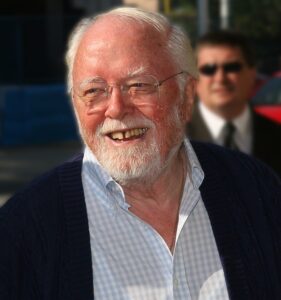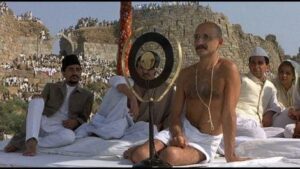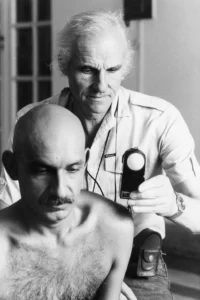
Gandhi : Vision of SIR Richard Attenborough!
Oct 02 2024
On the eve of Gandhi Jayanthi Remembering great motion picture “Gandhi” Directed by Sir Richard Attenborough

Interesting trivia about the Gandhi feature film by Richard Attenborough:

Above photo: Director Richard Attenborough
Production
Richard Attenborough spent 20 years researching and developing the film.
The film was shot in 100 locations across India, with a cast of 300,000 extras.
Ben Kingsley, a relatively unknown actor at the time, was chosen to play Gandhi after a worldwide search.

Accuracy and Authenticity
The film’s script was vetted by India’s government to ensure historical accuracy.
Attenborough consulted with Gandhi’s family and associates to ensure authenticity.
The film’s iconic salt march scene was recreated with 100,000 extras.

Awards and Recognition
1. Gandhi won 8 Academy Awards, including Best Picture and Best Director.
2. Ben Kingsley won Best Actor for his portrayal of Gandhi.
3. The film was nominated for 11 BAFTA Awards.
Impact and Legacy
Gandhi helped popularize Gandhi’s philosophy of non-violence globally.
The film inspired a new generation of Indians to learn about their nation’s history.
Gandhi is considered one of the greatest biopics of all time.
Interesting Casting Choices
Harrison Ford was initially offered the role of Walker, but turned it down.
Candice Bergen was cast as Margaret Bourke-White, but her scenes were deleted.
Martin Sheen played Walker, a journalist and Gandhi’s friend.
Filming Challenges
The film’s budget was $22 million, relatively low for an epic biopic.
Attenborough faced logistical challenges filming in India’s diverse landscapes.
Ben Kingsley had to lose weight and learn Indian languages for the role.
Gandhi film paved the way for first Indian to win Oscar in Costume designing Banu Athaiya
Above image: Cinematographer Billy Williams
Cinematography
Richard Attenborough’s “Gandhi” is a cinematic masterpiece, and its cinematography is truly iconic. Let’s dive into some of the most notable highlights.

Iconic Shots
– Gandhi’s Funeral Pyre: A poignant aerial shot of Gandhi’s cremation, capturing the magnitude of the event ¹.
– Salt March: A sweeping bird’s-eye view of the 100,000-strong procession, showcasing the determination of the Indian people.
– Train Station Departure_: Gandhi’s emotional farewell to his wife, Kasturba, highlighting the human side of the leader.
Cinematographic Techniques
-Natural Lighting: Cinematographer Billy Williams used natural light to create an authentic, documentary-style feel, drawing the audience into the world of 1940s India
-Warm Color Palette: Earthy tones evoke India’s vibrant culture and landscape, immersing viewers in the country’s rich heritage.
– Long Takes: Uninterrupted shots capture the chaos and intensity of protests, putting the viewer in the midst of the action.
Inspirational Frames
– Gandhi’s Spinning Wheel_: A simple yet powerful symbol of India’s struggle for independence.
– Reflection of Gandhi’s Face_: A poignant reflection in a puddle, symbolizing humility and introspection.
– Quit India” Speech_: The iconic speech is framed against a backdrop of Indian flags, emphasizing the call to action.
Awards and Legacy
Billy Williams’ cinematography earned him several prestigious awards, including the Academy Award, BAFTA Award, and American Society of Cinematographers (ASC) Award .
His work on “Gandhi” has inspired Indian cinematographers like Anil Mehta, and demonstrated the effective use of natural lighting and location shooting in historical dramas and biopics.
Article by
CJ Rajkumar
Author/ Cinematographer

